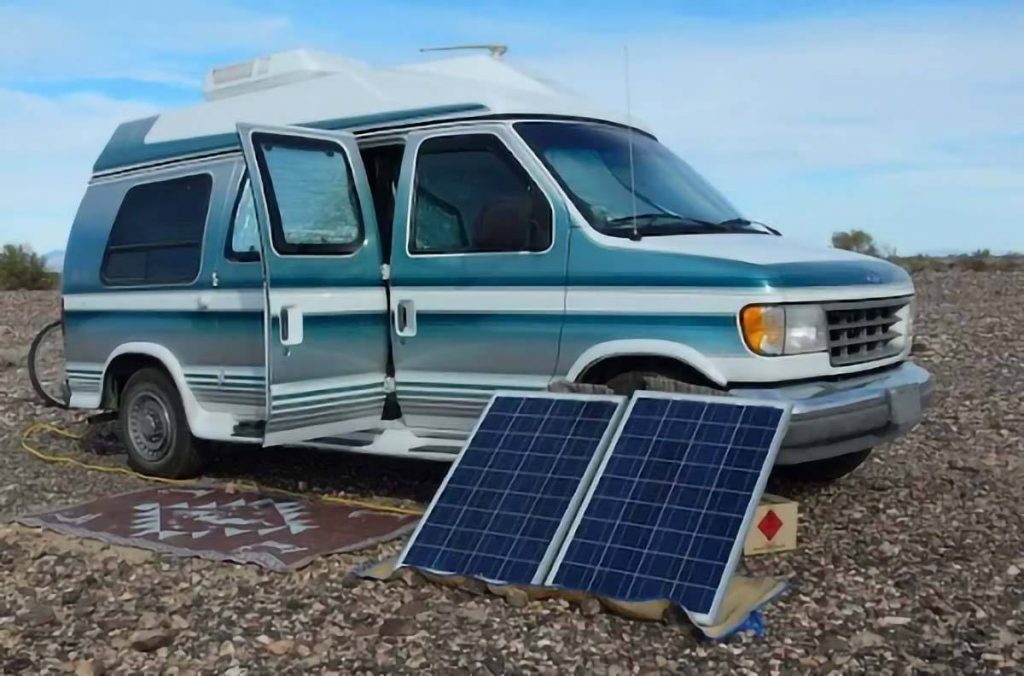
Overview:
Another common question we get asked is, can I run an air conditioner on solar power? Of course! If money is not an issue, you can do almost anything with solar. But the real question is, what is the minimum amount of RV solar power needed to power everything in your RV without wasting money? We’ll do this in three steps that include sizing your battery bank, calculating your RV solar power needs, and determining your solar requirements. keep reading!
How much RV solar power do I need? This is a question we get asked all the time. Look no further because today’s post will cover what you need to know to correctly calculate your solar array and battery bank needs.
Sizing Your Battery Pack
To estimate your total energy requirements for an RV solar panel, sum the daily usage of all the appliances in your RV like our example below. You can find common watt ratings with a quick Google search or by looking at the labels on your appliances. In the extended example below, a total of 139 amp hours are needed daily.
Amp Hour Calculation: Watt Hours ÷ Volts = Amp Hours

As mentioned above, batteries are rated in watt-hours or amp hours. Such as, you would need a battery or pack of batteries with a capacity that adds up to more than 139 amp hours or a means to recharge at a rate that is equal to or faster than the rate you’re consuming. Also, I compare lithium batteries to lead-acid batteries, to learn more. Here is the general calculation:
Usable Amp hours x Nominal Voltage = Usable Watt-hours
So, if you need 1500 Watt hours each day, it’s good to have at minimum 1500 Watt-hours of energy storage. This would equate to about 2 sets of 100-Amp-hour lithium batteries or 4 sets of 100-Amp-hour lead-acid batteries. Spaceflight power supply 12 voltage 100-Amp hour lithium battery and 12 voltage 100-amp hour lead acid battery, welcome to your call!
Calculating RV Solar Power Needs
The second step is to determine your maximum power requirement for your RV solar panel. According to our example above, we calculated 139 total amp hours are necessary daily, so, it is most important to also consider the continuous and peak discharge current your battery is capable of handling. Summing the total watts and dividing by the voltage of your battery will return current in amps if all appliances were in use at the same time: (2,356 watts ÷ 12.8 volts = 184.1 amps).
Current Calculation: Watts ÷ Volts = Current
-1024x234.png)
If your current in amps exceeds the continuous rating of your battery, you should limit the number of appliances used at one time or increase the number of batteries you have connected in parallel. If you exceed the peak current rating for longer than recommended, the battery’s monitoring system will close the battery down. Note that some appliances require extra RV solar power to start, which would also increase your demand for a short time. If you do not have enough current available to cover starting the device can not work. To have a consistent supply of daily RV solar power supply you’ll need a reliable method of replenishing what you use, which brings us to sizing your RV solar panels. But how much power solar panels actually make varies, depending on factors like location, season, weather, etc. What we will try to do, instead, is get a ballpark figure for the time of year and location you will be in.
-1024x604.jpg)
Determining Solar Demands
Solar is commonly available in 100-300 watt panels. Panel watt ratings are based on maximum efficiency. The weather, season, temperature, and time of day all affect how much power solar panels can generate. You will generate about 30 amps of power for every 100 watts of solar panels you have. You can use this as a general guideline when panel shopping. Inspect for yourself as you review panels by finding the output power or optimum current rating, most will be in the 5.4-5.8 amp range. Presuming you have six usable hours of sunlight in one day each 100-watt 5.5 amp panel will generate 33 amp hours day-to-day (5.5 amps x 6 hours = 33 amp hours).
To replenish the energy used in the extended example above (139.1 amp hours) you would need an array of panels totaling 500 watts. We arrive at this calculation from the guideline that each panel will produce about 30 amp hours each day in perfect states. If using five 100-watt panels that works out to 5 panels x 30 amp hours daily = 150 total amp hours, thus covering the 139 amp hours in the estimate. Even if 150 amp hours would cover the minimum daily necessary, it’s a great idea to oversize your array to build a cushion. Depending on how reliant you are on RV solar power as your only source, it’s a good idea to build in 20-25 percent capacity above your demands to be sure you’re not left short on a cloudy day or if you use more than expected.
Conclusion:
These basic calculations provide the essential information necessary to size your RV solar array. Even if you have figured out how much RV solar battery you need, you don’t have to install it all at once. Another option to make sure you don’t waste money is to install less solar than you think you need. You simply design the system with the ability to add more.
This might be by adding more panels in series or having extra wires pulled to the RV to connect them. Please contact us if you have any questions or would like assistance selecting the best Maxworld power batteries for your RV needs.
-1024x683.jpg)

-1024x683.jpg)
-e1628590578350.jpg)
